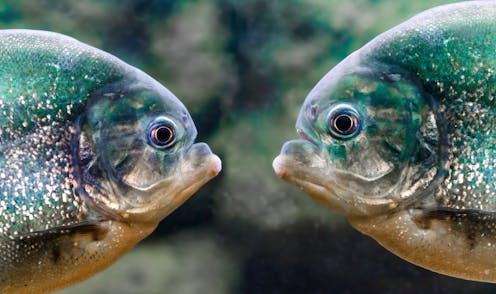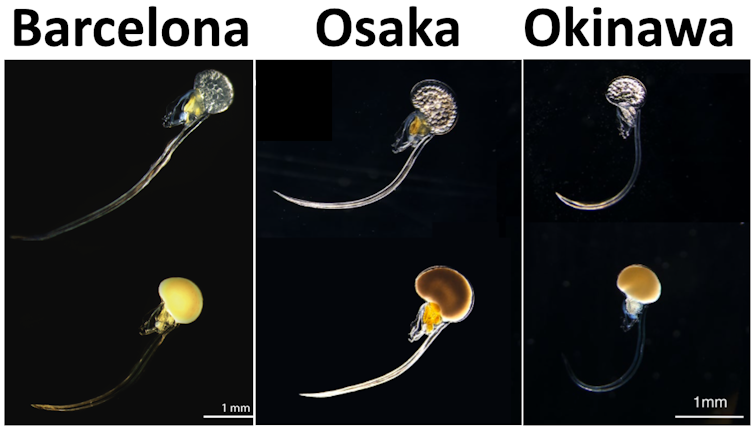
Logically speaking, you would think that animals who appeared to be the same – even if they were found in different parts of the world – would belong to the same species, and that they would share the same genome. However, our recent study has found that this is not always the case.
The discovery came thanks to a small zooplankton of the species Oikopleura dioica, which we have used as a model to understand the evolutionary origin of the genetic family to which humans belong – known as chordates.
This marine organism, found in warm seas, is the subject of our recent scientific article, published in Genome Research. It is the fruit of years of joint research carried out by the Genetics Department laboratory at the University of Barcelona and IRBio, in collaboration with the Okinawa Institute of Science and Technology and other Japanese and European universities.
By sequencing the genomes of Oikopleura dioica specimens from three separate areas – the Mediterranean Sea, the Pacific Ocean and the Okinawa Islands – we made a surprising discovery: each one was radically different, despite the fact that they have no obvious differences in appearance.
Appearances can be deceptive – but not genomes
Our finding has opened up new questions: Why do these large genetic differences not translate into obvious changes in animals’ physical appearances? Is it possible that, despite appearing to be the same, specimens from distant locations may actually belong to a different species?
It also raises the question of whether, for certain organisms, we should be cautious about using the concept of a “reference genome” for an entire species without first considering the possibility of discovering large genomic differences among organisms from different habitats.
To answer all these questions, we need to understand the genome as a kind of instruction manual, which contains all the genetic instructions to govern a living being.
It is made up of different chromosomes, which in turn contain thousands of genes. These are the basic units of genetic information that determine all the characteristics of each individual, and are inherited from one generation to the next.
As they replicate over thousands and thousands of generations, genomes accumulate changes, known as mutations. These cause the genetic information of each genome to change from one generation to the next, and once this information has changed a lot – to the point where organisms cannot interbreed and reproduce – a new species is made.
Leer más: What is a species? The most important concept in all of biology is a complete mystery
This accumulation of genetic changes is the basis of evolution, and it is essential for the generation of new species and increasing the planet’s biodiversity.
Using Lego to understand genetics
If we liken the organisation of a genome to that of a book or instruction manual, each chromosome would represent a chapter. In turn, the thousands of sentences that fill each chapter with information would be the genes distributed along the chromosomes.
If you compared the instruction books for two different Lego figures, you would expect to find significant differences between them, including in the structure of the chapters (chromosomes), in the order of their sentences (genes), and in their meaning (mutations).
Likewise, if you compared instructions on how to build the same Lego figure in different parts of the world, you would not expect to find any major differences between the instructions they gave.
However, in this analogy, the unexpected result has been that, when comparing the genomes of the “same” organisms from different parts of the world, they were different. The positions of most genes on chromosomes are in a completely different order, sometimes even jumping from one chromosome to another.
This is like reading two different Lego instruction manuals where all the steps and instructions are completely different, but you still, somehow, end up with the same figure. This discovery presents us with the new challenge of finding out why this remarkable rearrangement of genomes does not translate into major physical differences between species.
At the same time, it has led us to suspect that animals from different places might belong to different cryptic species – animals that, although they look very similar, actually belong to different species. These apparently similar species cannot interbreed or produce fertile offspring.
Indeed, the results of our preliminary experiments – using Oikopleura dioica specimens from Okinawa and Osaka – point to this being the case, as specimens from the two different areas cannot reproduce with one another.

All this suggests that what we hitherto believed to be a single species with a global (or cosmopolitan) distribution, is actually tens or even hundreds of different cryptic species scattered throughout the world’s oceans.
This is also an important finding when it comes to cataloguing our planet’s biodiversity. This is one of the goals of the “moonshot for biology” Earth Biogenome project, which aims to sequence the genomes of all eukaryote species on Earth within the next decade.
Our findings show that, for some organisms, we may not be able to pin down one singular reference genome for each species. This means that the biodiversity and number of species on the planet could be much higher than we had previously imagined.
Cristian Cañestro has received fund PID2022-141627NB-I00 for MICIU/AEI/ 10.13039/501100011033, and "FEDER una manera de hacer Europa", ICREA-Academia Ac2215698, and 2021SGR00372 AGAUR, Generalitat de Catalunya.
This article was originally published on The Conversation. Read the original article.







